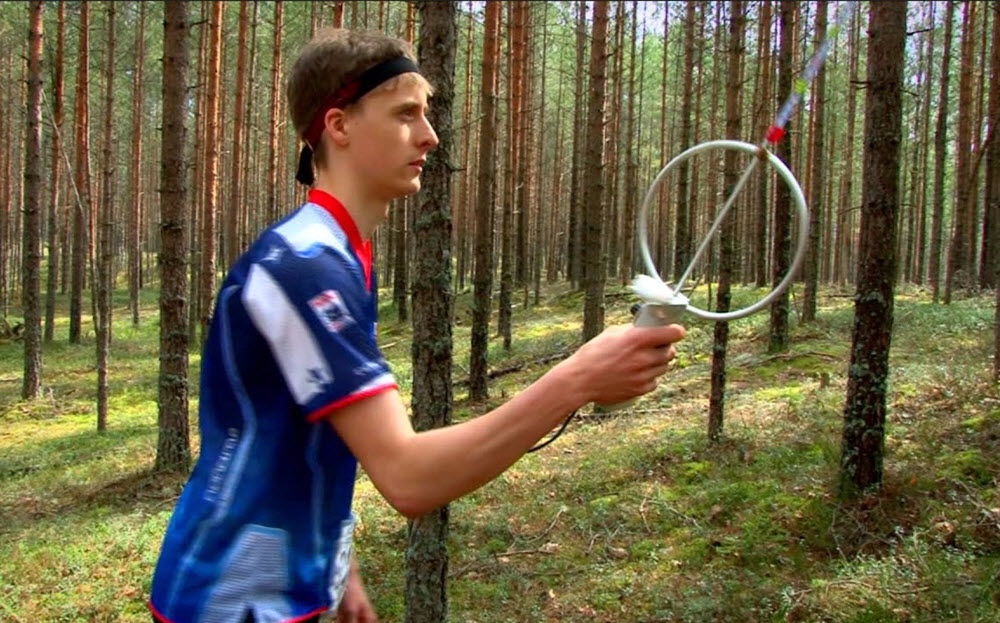Radio orienteering
Radio orienteering is a timed racing sport that combines orienteering and amateur radio. The formal name of this sport is amateur radio direction finding (ARDF). The highest governing body for ARDF is the International Amateur Radio Union.
During radio orienteering, individual contestants use a detailed topographic map, a magnetic compass, and a radio direction-finding apparatus. They must quickly navigate through the terrain and locate three or more (depending on the classification) low power radio transmitters.
The transmitters are not marked on the map; the contestants must use their apparatus to find them. The radio direction finding apparatus they carry includes a radio receiver, an attenuator, and a directional antenna. For practical reasons, the most popular design is the one where all these parts are integrated into one fairly small handheld device.
Radio orienteering developed in northern and eastern Europe in the 1950s.

Terrain
Just as with normal orienteering, the typical terrain for radio orienteering is diverse woodland.
Radio frequencies
ARDF events use radio frequencies on either the 2-meter or 80-meter amateur radio bands. These two bands are available to ham radio operators all over the world.
- Radio direction finding equipment for the 80 meter band (which is an HF band) is fairly easy to design and affordable to build.
- Radio direction finding equipment for the 2-meter band (which is a VHF band) is more complicated to design and costs more to build. Features in the terrain will have a bigger impact on 2-meter radio signals than on 80-meter radio signals. In order to be successful, the contestant must learn how to differentiate between correct, direct bearings and the false bearings produced when the signal is reflected by hillsides, buildings, ravines, or similar.
Large radio orienteering events will typically have one day devoted to 80-meter frequency orienteering and another day set aside for 2-meter frequency orienteering.
It is possible to purchase commercially available ARDF equipment, but building ones own equipment from various components is fairly common in the world of radio orienteering. Published designs and special kits are available.
Transmission
- Each of the five transmitters emits a unique signal in Morse code.
- The transmittors are set to automatically transmit one after another in a repeating cycle. They all transmitt on the same frequency. One transmittor transmitts for one minute, before it is time for the second, and so on.
- Historically, an orienteering punch device was used to prove that a contestant had located a transmittor. Today, major events normally use an electronic system instead of the traditional physical punch.
- Depending on entry classification, the contestant will locate three, four or five of the transmittors before heading to the finish line.
Rules
The highest governing body for ARDF is the International Amateur Radio Union (IARU) and the rules for the sport are maintained by the IARU Region I ARDF Working Group.
Variations
- Sprint events are designed to be shorter than normal events, and the expected winning time is around 15 minutes. The 80 meters band is used, and the transmittors only transmitt for 12 seconds each in the repeating cycle. With five transmittors, all have time to transmitt in one minute.
- Fox Oring is a variant that requires more orienteering skills than the standard radio orienteering events. The transmitters put out very little power and can only be detected from a short distance, typically 100 metres or less. The approximate location of each transmittor is marked by a circle on the map. If the contestant makes it to the circled area, they should be able to receive the transmission and use it to locate the exact position of the transmitter.
- Radio Orienteering in a Compact Area (ROCA) has less of a focus on athletics and more emphasis on technical radio directiong finding skills. The transmittors put ut very little power, normally 10 mW – 200 mW.
